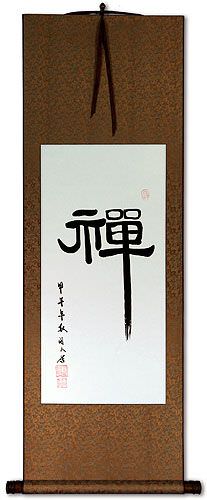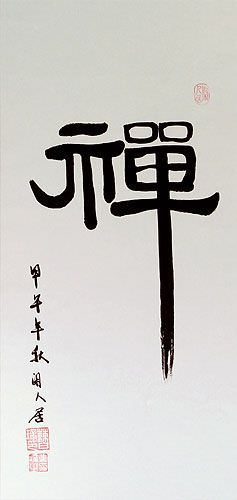
48¼"
20"

Approximate Measurements
Artwork Panel: 32.6cm x 67.3cm ≈ 12¾" x 26½"
Silk/Brocade: 41.8cm x 122.8cm ≈ 16½" x 48¼"
Width at Wooden Knobs: 50.8cm ≈ 20"

Close up view of the artwork mounted to this silk brocade wall scroll



Chinese / Japanese Kanji / old Korean Hanja Calligraphy Wall Scroll
This is the character that is Romanized and pronounced "Zen" in Japanese. This character actually means "meditation" and is often associated with a practice (and sect) of "Meditation Buddhism" or "Zen Buddhism". This character and concept originally came from China, where this character is Romanized and pronounced "Chan".
The form written on this scroll is one of a couple alternates used in China and Japan: 
This form can be considered the traditional Chinese and ancient Japanese form. Here's some info about the other ways to write this character...
In modern Japan, it's often written with three dots above the radical on the right: 
In China, this character was sometimes written in an alternate or "shorthand" form:  This shorthand form is now the official Simplified Chinese version, but this form has existed for over a thousand years.
This shorthand form is now the official Simplified Chinese version, but this form has existed for over a thousand years.
Want a Zen wall scroll completely customized to your desires?
Link: Options for custom Zen and Chan-related Chinese/Japanese/Korean calligraphy are available here!
This was painted by a friend named Cao Zhang. He's a Buddhist calligrapher who currently lives in Lakeside, California with his wife, son, and daughter. His daughter and mine are schoolmates, and my wife can often be found at his special Buddhist meditation sessions.
This is painted on xuan paper (often incorrectly called "rice paper"). The raw artwork was then taken to my workshop in east Beijing where the master mounter built it into a handmade wall scroll.